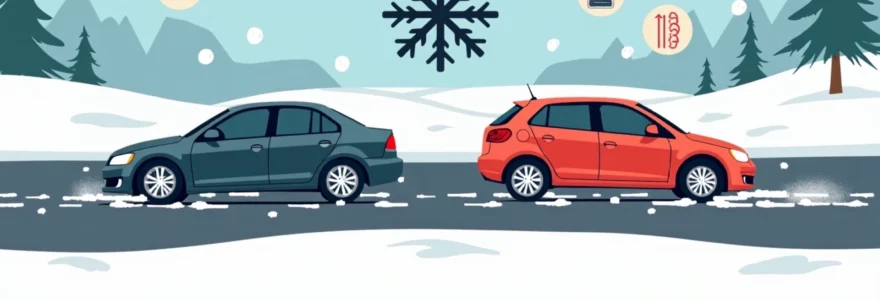As temperatures drop and winter approaches, ensuring your vehicle is ready for the challenges of cold weather driving becomes crucial. Proper preparation not only enhances your safety on icy roads but also protects your car from potential damage caused by harsh winter conditions. From essential maintenance tasks to emergency kit essentials, this comprehensive guide covers everything you need to know to keep your vehicle running smoothly and safely throughout the winter months.
Essential winter vehicle maintenance tasks
Preparing your car for winter involves several key maintenance tasks that should be performed before the cold weather sets in. These tasks focus on ensuring your vehicle's critical systems are in optimal condition to handle the unique challenges posed by winter driving conditions.
Check tire pressure tread depth
Proper tire maintenance is crucial for safe winter driving. As temperatures fluctuate, tire pressure can change, affecting your vehicle's handling and fuel efficiency. Use a tire pressure gauge to check the pressure in all tires, including the spare, and adjust as needed according to your vehicle's specifications. Remember that tire pressure typically drops by about 1 PSI for every 10-degree Fahrenheit decrease in temperature.
Equally important is assessing your tire's tread depth. Adequate tread depth is essential for maintaining traction on slippery winter roads. Use the penny test to check your tread depth: insert a penny into the tire's tread groove with Lincoln's head upside down and facing you. If you can see the top of Lincoln's head, your tread depth is less than 2/32 inch, and it's time to replace your tires.
Test battery charging system
Cold weather can be particularly hard on car batteries, often reducing their capacity by up to 50%. To avoid being stranded with a dead battery, have your battery and charging system tested by a professional before winter arrives. Most auto parts stores offer this service for free. If your battery is more than three years old or shows signs of weakness, consider replacing it proactively.
Additionally, inspect the battery terminals for corrosion and clean them if necessary. Corrosion can prevent proper electrical connections, leading to starting issues in cold weather.
Top off fluids replace wiper blades
Ensuring all your vehicle's fluids are at the proper levels is essential for winter preparedness. Check and top off the following fluids:
- Engine oil
- Coolant/antifreeze
- Brake fluid
- Power steering fluid
- Windshield washer fluid (use a winter-grade solution)
Pay special attention to your coolant/antifreeze mixture. The ideal ratio is typically 50/50 antifreeze to water, but consult your vehicle's manual for specific recommendations. This mixture helps prevent freezing and provides crucial protection for your engine in extreme temperatures.
Replacing your windshield wiper blades is another critical task. Winter precipitation can severely reduce visibility, making functional wiper blades essential for safe driving. Look for winter-specific wiper blades designed to prevent ice and snow buildup.
Winter emergency kit essentials
Preparing for the unexpected is a fundamental aspect of winter driving safety. Assembling a comprehensive winter emergency kit can make a significant difference if you find yourself stranded or facing a roadside emergency in cold weather. Here are the essential items to include in your winter emergency kit:
- Blankets or sleeping bags
- Extra warm clothing, including gloves, hats, and boots
- Non-perishable snacks and bottled water
- First-aid kit
- Flashlight with extra batteries
In addition to these basics, consider including the following items to handle winter-specific challenges:
Ice scraper and snow brush: These tools are indispensable for clearing snow and ice from your vehicle's windows and lights. Opt for a scraper with a long handle to reach across your windshield easily.
Shovel: A compact, folding shovel can help you dig your vehicle out of snow if you become stuck. Look for a lightweight, durable option that won't take up much space in your trunk.
Traction aids: Cat litter, sand, or traction mats can provide the extra grip needed to get your tires moving on slippery surfaces.
Jumper cables: Cold weather can drain your battery quickly. Having jumper cables on hand allows you to get a jump start from another vehicle if needed.
By keeping these items in your vehicle throughout the winter months, you'll be prepared to handle a variety of emergency situations that could arise during cold weather driving.
Preparing your vehicle for winter storage
For those who choose to store their vehicle during the winter months, proper preparation is key to ensuring it remains in good condition and is ready to hit the road when spring arrives. Follow these steps to prepare your vehicle for winter storage:
Clean interior exterior surfaces
Start by thoroughly cleaning both the interior and exterior of your vehicle. Remove all trash, vacuum the carpets and seats, and wipe down all surfaces. For the exterior, wash and wax your car to protect the paint from corrosion during storage. Pay special attention to the undercarriage, where road salt and grime can accumulate and cause rust over time. Consider applying a coat of wax or paint sealant for extra protection against moisture and oxidation during storage.
Add fuel stabilizer inflate tires
Before storing your vehicle, fill the gas tank to prevent moisture from accumulating inside the fuel system. Add a fuel stabilizer to keep the gasoline from deteriorating over time. Run the engine for a few minutes after adding the stabilizer to ensure it circulates through the entire fuel system.
Inflate your tires to the maximum pressure recommended on the sidewall. This helps prevent flat spots from forming during extended periods of inactivity. If possible, place the vehicle on jack stands to take the weight off the tires completely.
Disconnect battery prevent moisture buildup
To prevent battery drain during storage, disconnect the negative terminal of the battery. If storing for an extended period, consider using a battery maintainer to keep the battery charged and in good condition.
Moisture buildup can lead to mold, mildew, and unpleasant odors in your vehicle's interior. Place moisture-absorbing products, such as silica gel packets or a dehumidifier, inside the car to combat this issue. Additionally, leave the windows slightly cracked (if storing in a secure location) to allow for air circulation.
Remember, proper storage preparation can significantly extend the life of your vehicle and ensure it's ready to drive when you need it again.
Safe winter driving techniques
Mastering safe winter driving techniques is essential for navigating the challenging conditions that come with snow, ice, and slush. By adopting these practices, you can significantly reduce your risk of accidents and maintain control of your vehicle in adverse weather conditions.
Accelerate brake slowly maintain distance
One of the most critical aspects of winter driving is adjusting your speed and braking habits. Accelerate slowly to avoid spinning your wheels, especially when starting from a stop. When slowing down or stopping, apply the brakes gently and well in advance of where you need to stop. This gradual approach helps maintain traction and prevents skidding.
Maintaining a safe following distance is even more crucial in winter conditions. The standard three-second rule for following distance should be increased to at least six seconds on snowy or icy roads. This extra space gives you more time to react to sudden changes in traffic or road conditions.
Avoid cruise control slippery roads
While cruise control is a convenient feature for highway driving in good conditions, it can be dangerous on slippery winter roads. Using cruise control in snow, ice, or even rain can cause your vehicle to accelerate when it loses traction, potentially leading to a loss of control. Always maintain manual control of your vehicle's speed in winter driving conditions. Your reaction time and ability to modulate the accelerator are crucial for maintaining control on slippery surfaces.
Steer into skid regain traction
If you find your vehicle beginning to skid, it's important to know how to react quickly and effectively. The key is to steer into the skid – turn your wheels in the direction that the rear of the vehicle is sliding. This counterintuitive action helps your tires regain traction and straighten out the vehicle.
As you steer into the skid, avoid slamming on the brakes. Instead, ease off the accelerator and allow the car to slow down naturally. Once you've regained control, gently apply the brakes if needed to further reduce your speed.
Practice these techniques in a safe, empty parking lot when winter weather first hits to build confidence and muscle memory for real-world situations.
Choosing the right winter tires
When it comes to winter driving safety, few decisions are as important as choosing the right tires for your vehicle. Winter tires, also known as snow tires, are specifically designed to provide superior traction and handling in cold weather conditions, including snow, ice, and slush.
Here are key factors to consider when selecting winter tires:
Tread pattern: Look for tires with deep, aggressive tread patterns. These designs feature wider grooves and more sipes (small slits in the tread blocks) that help channel snow and slush away from the tire's surface, improving grip on snowy roads.
Rubber compound: Winter tires use a softer rubber compound that remains flexible in cold temperatures, allowing for better traction. This specialized compound helps the tire conform to road surfaces more effectively, even when temperatures drop below freezing.
Size and fit: Ensure you choose the correct size for your vehicle. Some drivers opt for slightly narrower tires for winter use, as they can cut through snow more effectively. However, always consult your vehicle's manual or a tire professional to ensure proper fitment.
Performance ratings: Look for tires with the 3PMSF (Three-Peak Mountain Snowflake) symbol, which indicates they've passed specific snow traction performance tests. This rating is more stringent than the older M+S (Mud and Snow) designation.
When installing winter tires, it's crucial to replace all four tires simultaneously. Using winter tires only on the drive wheels can lead to unpredictable handling and increased risk of losing control.
Investing in a set of high-quality winter tires can significantly enhance your vehicle's performance and safety during the cold months. Combined with proper vehicle maintenance and safe driving techniques, the right winter tires provide the confidence and control you need to navigate challenging winter road conditions safely.

